
Decorating your home with house plants can bring life and color to any space. Whether you’re a beginner or a seasoned plant lover, choosing the right plants is essential for creating a happy and healthy indoor garden.
With so many options available, it can be challenging to know where to start. From considering the type of light in your home to understanding how much care each plant needs, there are several important factors to keep in mind.
In this guide, we’ll explore helpful tips that will make it easier for you to select the perfect house plants for your lifestyle and space.
1. Consider Your Space Requirements
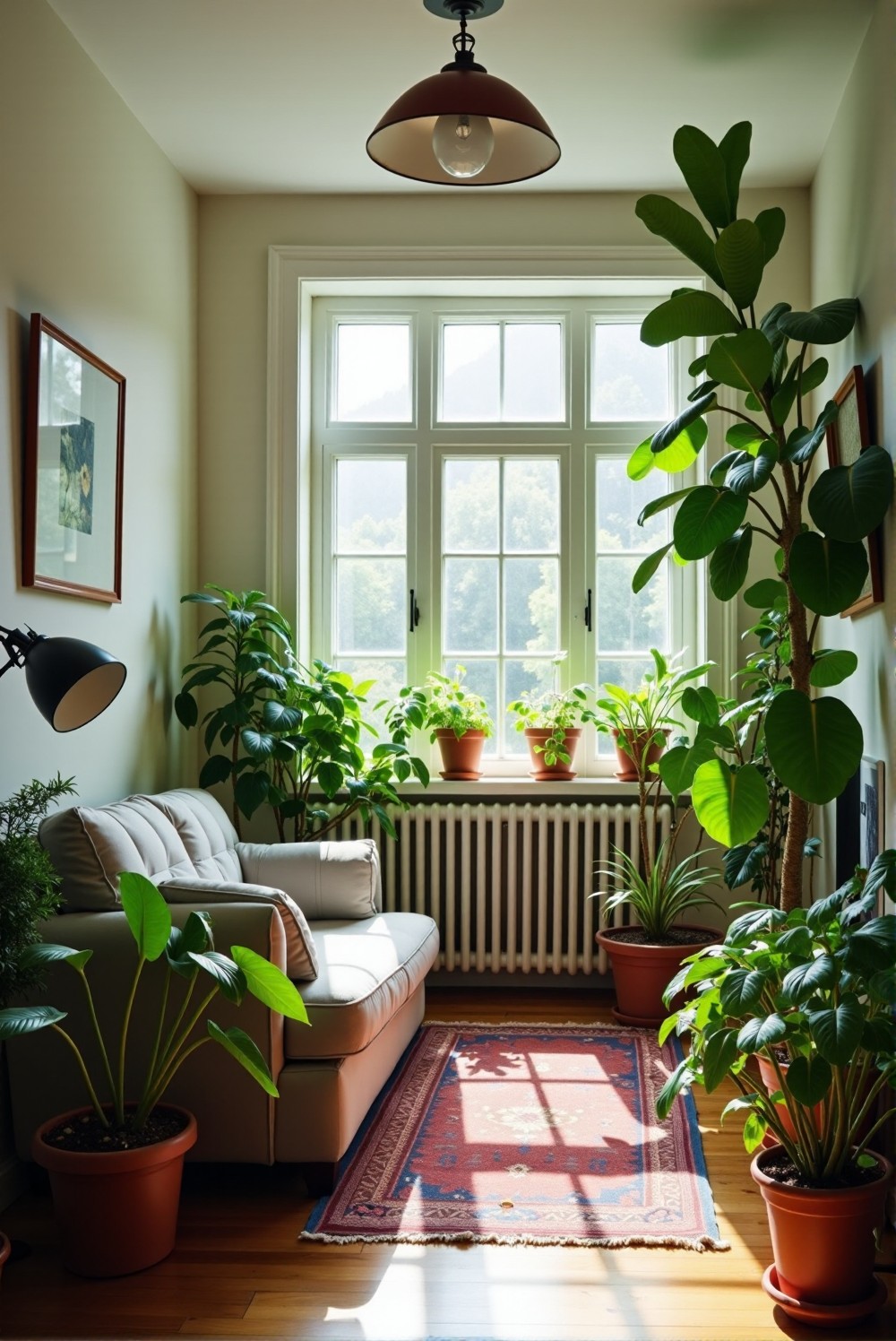
Understanding your space needs is crucial when selecting house plants. Different plants thrive in varying amounts of space.
Some need a lot of room to grow tall or spread wide, while others can flourish in tighter spots. Start by measuring the area where you plan to place your plant.
Consider the height, width, and the amount of light that area gets. This will help you find a plant that fits well.
Also, think about how much floor or table space you want to use. A smaller plant may work better in a cozy corner, while a larger plant might make a statement in a bigger room.
When selecting plants for your space, consider their size and placement to enhance your interior decor. Here are some points to keep in mind:
- Evaluate the available space and choose plant sizes that complement your furniture arrangement.
- Utilize vertical space by incorporating shelving or hanging planters for smaller plants.
- Group smaller plants together for a cohesive look that can fill empty spots without overwhelming the area.
- For larger rooms, consider tall plants that draw the eye upward and add depth to the design.
- Always consider the light requirements of the plants you choose to ensure they thrive in their designated spot.
Make sure there’s enough space for your plant so it can grow healthy, without crowding other items. By keeping these details in mind, you’ll create a welcoming and suitable environment for your new plant.
2. Assess Light Conditions

Light plays a vital role in the health of house plants. Different plants need different amounts of light to grow strong and beautiful.
Start by observing where you want to place your plant. Is it near a window, or is it in a darker corner?
Natural light changes throughout the day, so consider how much light the area gets at different times.
Some plants thrive in bright, direct sunlight, while others prefer indirect light or shade.
If the spot isn’t adequately lit, your plant might become weak or droopy. You can tell if a plant is getting enough light if it grows steadily and the leaves stay green.
You can use reflectors or mirrors to help bounce light into darker areas for plants that need a little extra. For spots that get too much direct sunlight, consider sheer curtains to soften the light.
Check for signs of too much or too little light. Leaves may get brown tips from too much sunlight or become leggy and stretch out for more light if it’s not enough.
Always adjust the placement based on your plant’s needs to ensure a healthy growth environment.
When caring for plants, it’s essential to consider their specific requirements for optimal growth. Adjusting their placement can significantly impact their health and development. Here are some key points to keep in mind:
- Evaluate sunlight exposure: Ensure your plant receives the right amount of light based on its species.
- Monitor temperature changes: Keep plants away from drafts or extreme heat sources to maintain a stable environment.
- Consider humidity levels: Some plants thrive in higher humidity, so placing them in a suitable location is crucial.
- Check for airflow: Good air circulation helps prevent mold and pests, contributing to overall plant health.
- Regularly reassess placement: As seasons change, periodically review your plant’s location to accommodate its growing needs.
3. Understand Watering Needs

Watering is one of the most important parts of plant care. Each plant has its own specific needs when it comes to water.
Some thrive with a lot of moisture, while others prefer to dry out between waterings. Knowing what your plant likes is key.
Check soil moisture to determine when it’s time to water. You can do this by sticking your finger about an inch into the soil.
If it feels dry, it’s time to give your plant a drink. If it’s still moist, wait a little longer.
Overwatering can lead to root rot, which is often fatal for plants.
The type of pot you use also affects how often you need to water.
Pots with drainage holes allow excess water to escape, helping prevent soggy roots. However, self-watering pots provide consistent moisture and can be great for forgetful waterers.
Temperature and humidity can influence how quickly soil dries out. During hot, dry days, plants might need more water.
On cooler days, water needs decrease. Always adjust your routine based on the season and environment.
While keeping an eye on water levels, remember that plants may also show signs of thirst. Droopy leaves or brown edges can indicate a need for water.
However, other issues might cause similar symptoms, so it’s crucial to examine care conditions closely.
Implementing a regular watering schedule can help establish good habits.
Just be flexible and ready to adapt based on your plant’s response. A little attention to these needs will keep your houseplants happy and healthy.
4. Choose Low Maintenance Options

Choosing plants that require less care can make your life easier. Look for species known for their hardiness.
Plants like succulents and snake plants are great options. They can often survive with limited watering and still look good.
Consider the light requirements as well, as many low-maintenance plants don’t need bright sunlight. This means you can place them in various locations within your home without worrying too much about their light needs.
Additionally, opt for plants that naturally resist pests and diseases. This reduces the need for constant monitoring and treatment.
By picking the right varieties, you will spend less time worrying about upkeep and more time enjoying your home.
Also, self-watering pots can be a useful investment.
They help maintain consistent moisture levels, making care even simpler. This way, you can enjoy the beauty of plants without the stress of frequent watering.
Discover the advantages of maintaining moisture levels in your plants, ensuring a beautiful and low-maintenance gardening experience.
- Reduces the frequency of watering, saving you time and effort.
- Promotes healthier plant growth due to stable moisture conditions.
- Helps prevent overwatering, which can lead to root rot and plant stress.
- Provides a more forgiving environment for both novice and experienced gardeners.
- Enhances the overall aesthetic of your space with thriving plants.
By selecting low-maintenance options, you’re not only reflecting your style but also setting yourself up for success.
5. Think About Your Lifestyle
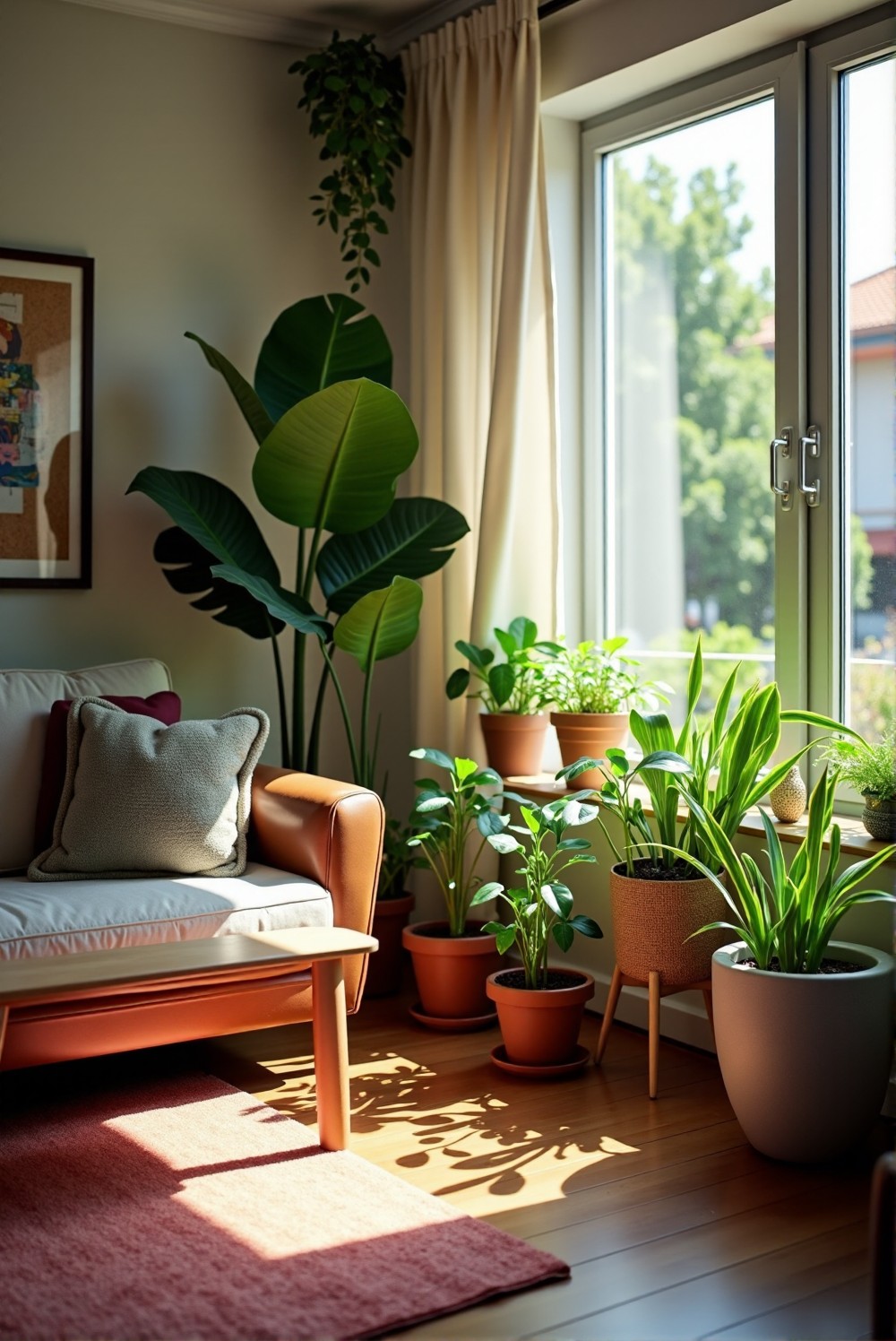
Your daily routine plays a big role in which house plants will work best for you. If you’re often away from home, it’s smart to choose hardy types that don’t need frequent care.
Plants like cacti or ZZ plants can thrive with minimal attention, making them perfect for busy lifestyles.
Think about how much time you can realistically commit to your plants.
If you travel a lot or have a hectic schedule, plants that require less watering and maintenance are ideal. For those who enjoy caring for plants but may forget sometimes, self-watering pots can be a great help.
Your lifestyle also affects how often you’re at home to enjoy your plants. If you like to relax and spend time around greenery, consider larger statement plants.
They can create a calming atmosphere. On the other hand, if you’re not around much, smaller plants that can be tucked into corners or shelves may be better.
Additionally, consider any pets you might have. Some plants can be toxic to animals, so it’s wise to choose non-toxic options if you have curious pets wandering around.
Ultimately, selecting plants that fit your lifestyle will make caring for them enjoyable rather than a chore. This way, you can fully appreciate the beauty and benefits of having plants in your home.
6. Research Plant Toxicity

Before bringing any plant into your home, it’s essential to understand if it could be harmful, especially if you have pets or young children. Some plants contain toxins that can cause serious health issues if ingested.
It’s wise to look up plant species and their toxicity levels before making your decision.
For example, common houseplants like poinsettias and philodendrons can be toxic to pets.
Symptoms can include vomiting, drooling, or even more severe reactions. Always research plants thoroughly to ensure that they’re safe for those who will be around them.
There are many resources available online and at local libraries that list poisonous plants. Websites from trusted organizations can offer guidance on which plants to avoid and safer alternatives to consider.
Knowing this information can help you create a safer environment in your home.
Choosing non-toxic plants is especially important for households with curious pets.
Consider safer options such as spider plants or bamboo palms, which are non-toxic and still bring wonderful greenery into your space.
By taking time to understand plant toxicity, you can enjoy the beauty of greenery in your home without worrying about the safety of your loved ones.
This research is a vital step in your journey of selecting the perfect houseplants.
7. Explore Different Sizes
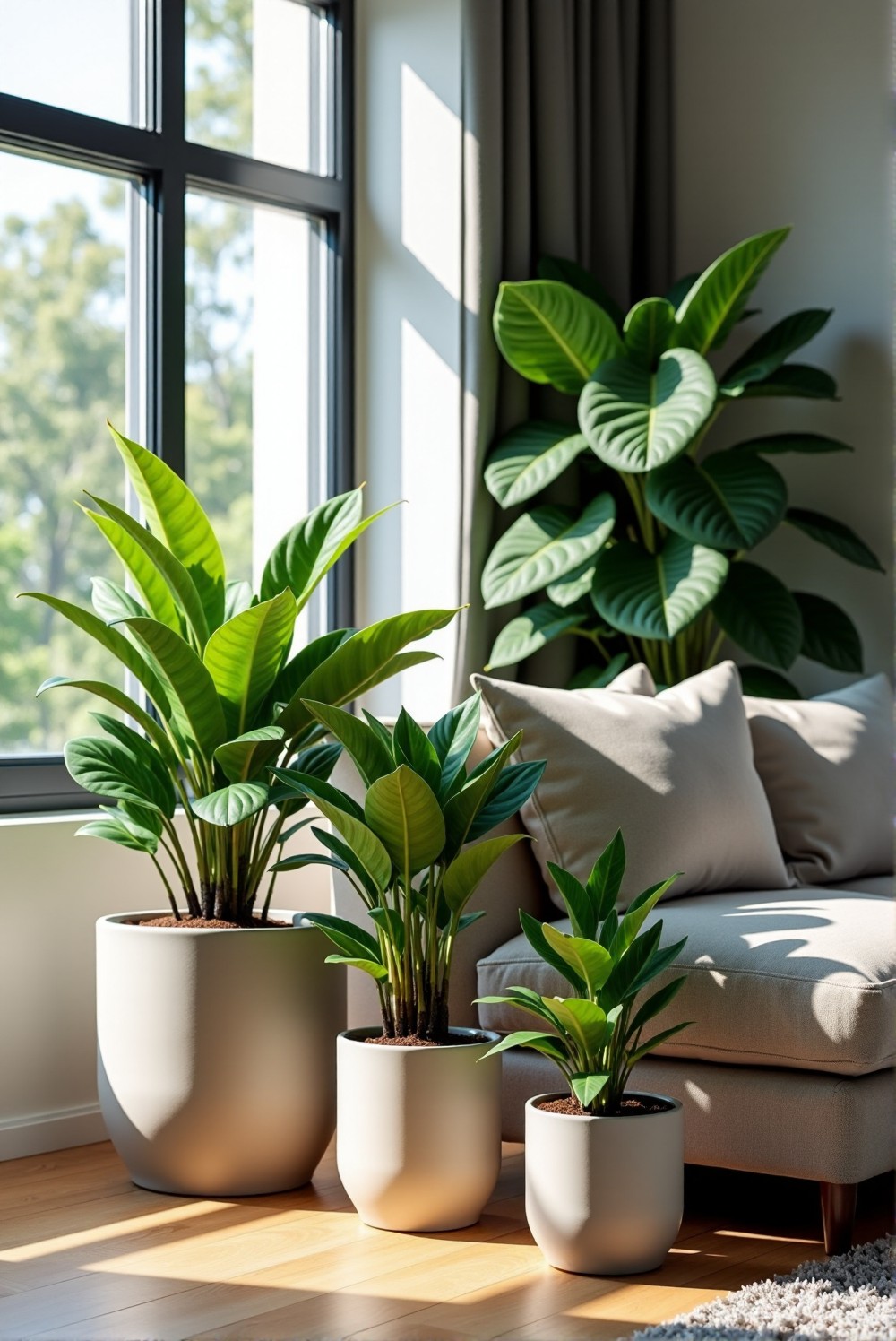
When it comes to choosing house plants, size matters a lot. Different plants come in a variety of sizes, and picking the right one can help your space feel more balanced.
Large plants can make a bold statement, while smaller ones can fit nicely in tight corners or on shelves. It’s all about finding what works best for your home.
Consider how big a plant will get over time. Some plants start small but can grow quite large if given the right conditions.
Others stay petite, making them easier to manage in smaller spaces. Think about the space you have now and how it might change.
If you have a new spot in mind for your plant, will it still fit as it grows?
Group plants of different sizes together for a dynamic look.
Larger plants can complement smaller ones and create interesting displays. A tall plant next to a smaller one can add depth to your room.
Also, remember that larger pots often mean heavier plants. If you choose a big one, make sure you can easily move it if needed.
Look for sturdy pots that are well-designed to hold your plant securely.
Ultimately, exploring various sizes can enhance your decor and make your space inviting.
Pay attention to how the size of your plants relates to the room’s layout and your furniture. This will help you create a pleasing environment that showcases your green companions beautifully.
8. Check Humidity Levels
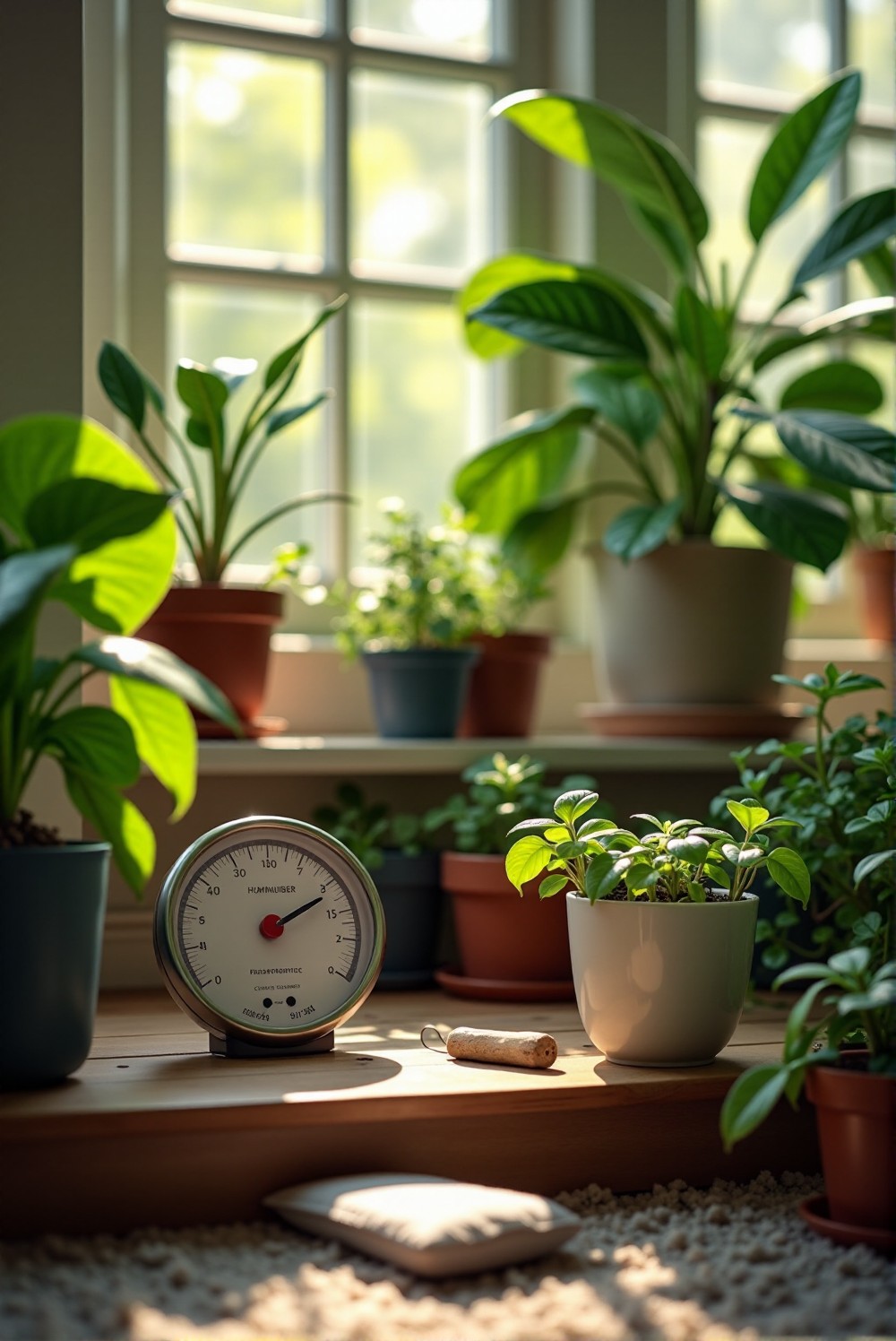
Humidity is an important factor for many house plants. Some plants grow best in moist air, while others like it drier.
Checking the humidity levels in your home can help you choose the right plants.
Plants like ferns and tropical varieties typically need higher humidity.
You can create a more humid environment by placing a tray of water near the plants or using a humidifier. Misting leaves can also help raise humidity, but be careful not to overdo it, as too much water can lead to mold.
On the other hand, plants such as succulents or cacti thrive in lower humidity. These plants prefer dryer air and don’t do well with too much moisture.
Using a humidity meter can help you measure the levels effectively. These are small devices that indicate the moisture in the air.
If your home tends to be dry, especially during winter, you might need to increase the humidity for your moisture-loving plants.
Paying attention to humidity levels is key for happy, healthy plants.
By creating the right atmosphere for them, you encourage growth and vibrant leaves.
9. Experiment with Colors and Textures
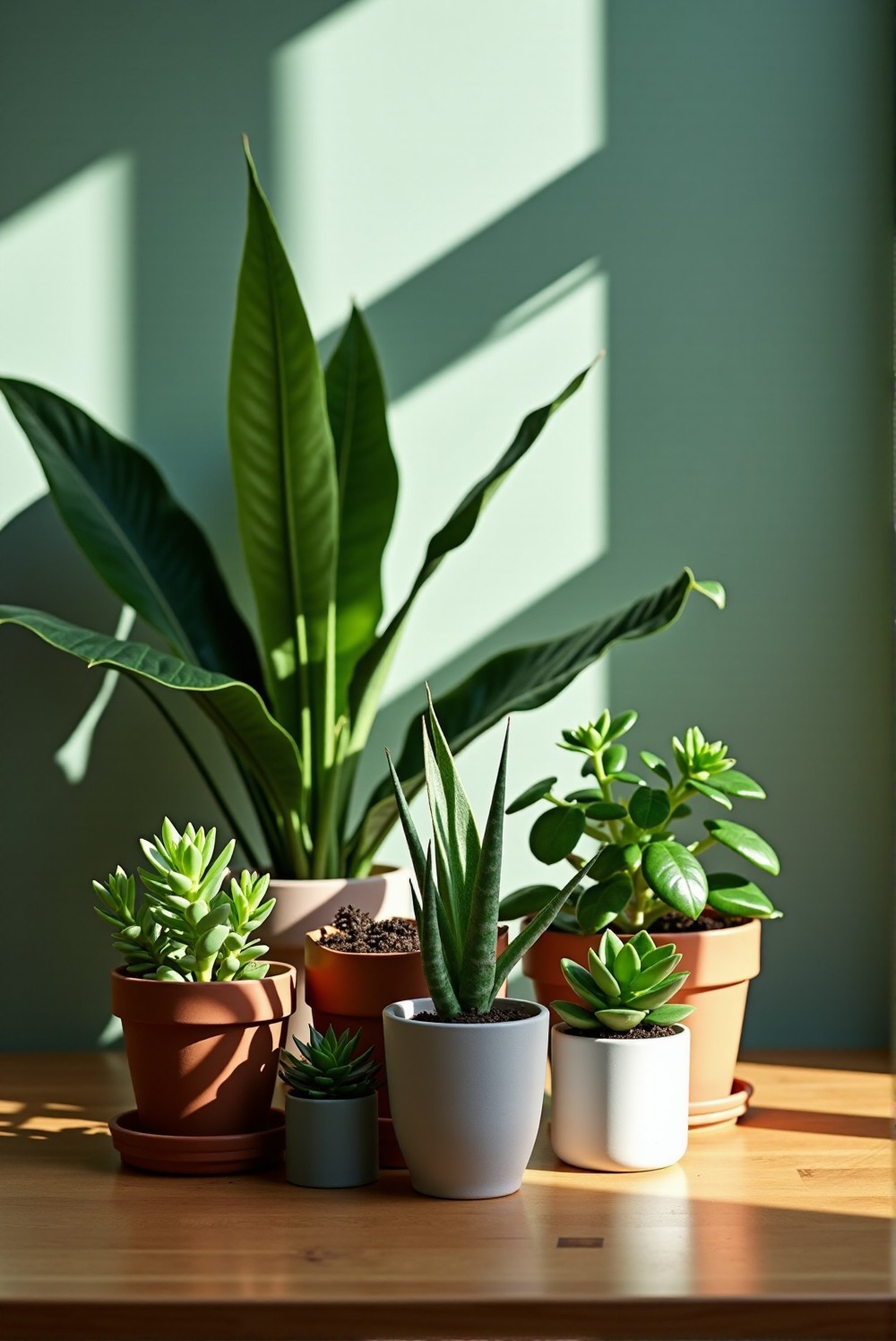
Using different colors and textures can make your space more inviting. When you think about house plants, consider how their colors will fit with your home decor.
For example, a bright green plant can really pop against a neutral wall, while colorful flowers can add a cheerful touch to any room.
Textural variety also adds depth.
Plants with smooth leaves, like rubber plants, contrast beautifully with those that have textured foliage, such as ferns. Mixing these can create interest and keep your indoor garden looking vibrant.
Don’t be afraid to play with the arrangement. Grouping plants with similar colors can create a serene look, while mixing bold colors can energize a space.
Think of how different shapes and heights can work together, too. A tall plant next to a bushier one can make a striking visual impact.
Experimenting with containers is another fun way to introduce color and texture. Choose pots that complement your plants and the overall style of your room.
A sleek ceramic pot can add elegance, while a rustic wooden planter brings warmth.
Overall, let your creativity shine.
Choosing the right planter can significantly enhance your space’s aesthetic. Below is a comparison of different types of planters that you might consider.
| Type of Planter | Material | Aesthetic | Best For |
|---|---|---|---|
| Ceramic Pot | Ceramic | Elegant | Modern spaces |
| Wooden Planter | Wood | Rustic | Traditional decor |
| Metal Planter | Metal | Industrial | Urban settings |
| Plastic Planter | Plastic | Versatile | Outdoor use |
| Woven Basket | Natural fibers | Casual | Bohemian style |
Your choices can reflect your personal style and turn your home into a cozy oasis filled with beauty.
10. Consult Local Experts

Talking to local experts can give you a big advantage when selecting house plants. These people usually have a wealth of knowledge about which plants grow well in your area and what care they need.
You might find expertise at garden centers, plant nurseries, or even local botanical gardens.
When you visit these places, ask questions!
Find out which plants do well indoors and what they recommend for beginners or specific conditions. Local experts can also provide tips based on your home’s environment-like light levels and humidity.
Many communities hold workshops or classes where experts share their knowledge about plant care. Attending these events can help you feel more confident about your plant choices and learn useful skills for keeping them healthy.
If you’re unsure about a plant or its care requirements, don’t hesitate to ask for advice. Whether it’s about watering schedules, pest control, or repotting, the insights from someone experienced can be incredibly valuable.
When it comes to choosing house plants, leveraging local expertise can enhance your selection process significantly. Here are some key benefits of consulting with local experts:
- Access to tailored advice specific to your region’s climate and conditions.
- Insights into the best varieties of plants that thrive in your local environment.
- Recommendations based on soil types, sunlight availability, and humidity levels typical in your area.
- Information on common pests and plant diseases prevalent in your locality, along with preventative care tips.
- Connection to local resources, such as nurseries and gardening clubs that can further assist in your plant care journey.
Also, consider joining local gardening clubs or online forums where enthusiasts share their experiences. People in these groups can recommend plants that suit your needs and give tips on how to care for them based on firsthand experience.
In the end, consulting local experts not only helps you choose the right plants but also increases your chances of success in keeping them happy and thriving at home.
Frequently Asked Questions
Welcome to our FAQ section where we answer some common questions about choosing the right house plants. Whether you’re a beginner or an experienced plant enthusiast, these answers will help guide your selection process.
What should I consider when choosing house plants for my space?
When selecting house plants, it’s important to evaluate the space you have available. Measuring the height and width of the area can help ensure you choose plants that will thrive without crowding.
Additionally, consider the amount of natural light that area receives. Different plants have varying light needs, so understanding these requirements will help you select the right species for your environment.
How do I know how much light my plants need?
Light conditions are critical for the health of house plants. Each plant species has its own light requirements, with some thriving in bright, direct sunlight while others prefer indirect light or shade.
Observe the specific location where you plan to place the plants and track how much light it receives throughout the day. This will help you determine if the area is suitable for the plants you are considering.
What are some low-maintenance house plant options?
If you’re looking for plants that require less care, consider hardy species such as succulents or snake plants. These varieties can survive with minimal watering and are typically resilient against pests.
Additionally, they often adapt well to various light conditions, making them versatile choices for different areas of your home. Choosing low-maintenance plants can greatly reduce the effort you need to put into plant care.
Why is it important to research plant toxicity?
Understanding plant toxicity is crucial, especially for households with pets or small children. Certain plants can be harmful if ingested, leading to serious health issues.
Researching the plants you’re interested in will allow you to identify which ones are non-toxic and safe for your living environment. This proactive step ensures that you can enjoy your greenery without putting your loved ones at risk.
How can humidity levels affect my choice of house plants?
Humidity is a significant factor for many house plants, with certain species thriving in moist environments while others prefer drier conditions. By checking the humidity levels in your home, you can make more informed decisions about which plants will thrive.
Creating the right humidity conditions can involve using trays of water or humidifiers, especially for plants that prefer higher humidity. Understanding these needs will contribute to healthier, more vibrant plants in your home.
What are the benefits of consulting local plant experts?
Consulting local experts can provide valuable insights tailored to your specific area’s climate and plant care needs. Garden centers and botanical gardens are great places to seek advice on which plants grow best in your environment.
These experts can offer recommendations based on their experience and knowledge of local conditions, enabling you to make informed plant choices. This guidance can increase your chances of success in keeping your house plants happy and healthy.
Conclusion
Choosing the right house plant can bring joy and life to your home. It’s important to consider factors like space, light, watering needs, and plant toxicity.
By taking your time to learn about different plants and their care, you can create a vibrant indoor garden that fits your lifestyle.
Don’t forget to experiment with different sizes, colors, and textures to make your space unique.
Consulting local experts can also provide valuable insights to help you make informed decisions.
With these tips, you’ll be well-equipped to find the perfect plants that thrive in your home and bring you happiness for years to come.